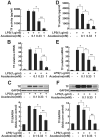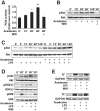Acadesine inhibits tissue factor induction and thrombus formation by activating the phosphoinositide 3-kinase/Akt signaling pathway
- PMID: 20185792
- PMCID: PMC3626455
- DOI: 10.1161/ATVBAHA.110.203141
Acadesine inhibits tissue factor induction and thrombus formation by activating the phosphoinositide 3-kinase/Akt signaling pathway
Abstract
Objective: Acadesine, an adenosine-regulating agent and activator of AMP-activated protein kinase, has been shown to possess antiinflammatory activity. This study investigated whether and how acadesine inhibits tissue factor (TF) expression and thrombus formation.
Methods and results: Human umbilical vein endothelial cells and human peripheral blood monocytes were stimulated with lipopolysaccharide to induce TF expression. Pretreatment with acadesine dramatically suppressed the clotting activity and expression of TF (protein and mRNA). These inhibitory effects of acadesine were unchanged for endothelial cells treated with ZM241385 (a specific adenosine A(2A) receptor antagonist) or AMP-activated protein kinase inhibitor compound C, and in macrophages lacking adenosine A(2A) receptor or alpha1-AMP-activated protein kinase. In endothelial cells and macrophages, acadesine activated the phosphoinositide 3-kinase/Akt signaling pathway, reduced the activity of mitogen-activated protein kinases, and consequently suppressed TF expression by inhibiting the activator protein-1 and NF-kappaB pathways. In mice, acadesine suppressed lipopolysaccharide-mediated increases in blood coagulation, decreased TF expression in atherosclerotic lesions, and reduced deep vein thrombus formation.
Conclusion: Acadesine inhibits TF expression and thrombus formation by activating the phosphoinositide 3-kinase/Akt pathway. This novel finding implicates acadesine as a potentially useful treatment for many disorders associated with thrombotic pathology, such as angina pain, deep vein thrombosis, and sepsis.
Figures





Similar articles
-
Exogenous Bradykinin Inhibits Tissue Factor Induction and Deep Vein Thrombosis via Activating the eNOS/Phosphoinositide 3-Kinase/Akt Signaling Pathway.Cell Physiol Biochem. 2015;37(4):1592-606. doi: 10.1159/000438526. Epub 2015 Nov 2. Cell Physiol Biochem. 2015. PMID: 26517864
-
NMMHC IIA inhibition impedes tissue factor expression and venous thrombosis via Akt/GSK3β-NF-κB signalling pathways in the endothelium.Thromb Haemost. 2015 Jul;114(1):173-85. doi: 10.1160/TH14-10-0880. Epub 2015 Apr 16. Thromb Haemost. 2015. PMID: 25881103 Free PMC article.
-
Puerarin inhibits expression of tissue factor induced by oxidative low-density lipoprotein through activating the PI3K/Akt/eNOS pathway and inhibiting activation of ERK1/2 and NF-κB.Life Sci. 2017 Dec 15;191:115-121. doi: 10.1016/j.lfs.2017.10.018. Epub 2017 Oct 14. Life Sci. 2017. PMID: 29037842
-
Acadesine, an adenosine-regulating agent with the potential for widespread indications.Expert Opin Pharmacother. 2008 Aug;9(12):2137-44. doi: 10.1517/14656566.9.12.2137. Expert Opin Pharmacother. 2008. PMID: 18671468 Review.
-
Tissue factor and thrombosis: The clot starts here.Thromb Haemost. 2010 Sep;104(3):432-9. doi: 10.1160/TH09-11-0771. Epub 2010 Jun 10. Thromb Haemost. 2010. PMID: 20539911 Free PMC article. Review.
Cited by
-
Inhibition of interleukin-1β-induced endothelial tissue factor expression by the synthetic cannabinoid WIN 55,212-2.Oncotarget. 2016 Sep 20;7(38):61438-61457. doi: 10.18632/oncotarget.11367. Oncotarget. 2016. PMID: 27556861 Free PMC article.
-
Ref-1 protects against FeCl3-induced thrombosis and tissue factor expression via the GSK3β-NF-κB pathway.Korean J Physiol Pharmacol. 2021 Jan 1;25(1):59-68. doi: 10.4196/kjpp.2021.25.1.59. Korean J Physiol Pharmacol. 2021. PMID: 33361538 Free PMC article.
-
AICAR inhibits NFκB DNA binding independently of AMPK to attenuate LPS-triggered inflammatory responses in human macrophages.Sci Rep. 2018 May 17;8(1):7801. doi: 10.1038/s41598-018-26102-3. Sci Rep. 2018. PMID: 29773845 Free PMC article.
-
AMP-activated protein kinase α1 protects against diet-induced insulin resistance and obesity.Diabetes. 2012 Dec;61(12):3114-25. doi: 10.2337/db11-1373. Epub 2012 Jul 24. Diabetes. 2012. Retraction in: Diabetes. 2013 Mar;62(3):998. doi: 10.2337/db13-rt03. PMID: 22829451 Free PMC article. Retracted.
-
Deletion of pancreatic β-cell adenosine kinase improves glucose homeostasis in young mice and ameliorates streptozotocin-induced hyperglycaemia.J Cell Mol Med. 2019 Jul;23(7):4653-4665. doi: 10.1111/jcmm.14216. Epub 2019 May 1. J Cell Mol Med. 2019. PMID: 31044530 Free PMC article.
References
-
- Mangano DT. Effects of acadesine on myocardial infarction, stroke, and death following surgery. A meta-analysis of the 5 international randomized trials. The Multicenter Study of Perioperative Ischemia (McSPI) Research Group. JAMA. 1997;277:325–332. - PubMed
-
- Mangano DT, Miao Y, Tudor IC, Dietzel C. Post-reperfusion myocardial infarction: long-term survival improvement using adenosine regulation with acadesine. J Am Coll Cardiol. 2006;48:206–214. - PubMed
-
- Dietrich WD, Miller LP, Prado R, Dewanjee S, Alexis N, Dewanjee MK, Gruber H. Acadesine reduces indium-labeled platelet deposition after photothrombosis of the common carotid artery in rats. Stroke. 1995;26:111–116. - PubMed
-
- Gruber HE, Hoffer ME, McAllister DR, Laikind PK, Lane TA, Schmid-Schoenbein GW, Engler RL. Increased adenosine concentration in blood from ischemic myocardium by AICA riboside. Effects on flow, granulocytes, and injury. Circulation. 1989;80:1400–1411. - PubMed
Publication types
MeSH terms
Substances
Grants and funding
LinkOut - more resources
Full Text Sources
Medical
Research Materials
Miscellaneous

